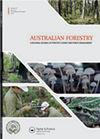蓝桉精油性状遗传参数研究
IF 1.2
4区 农林科学
Q3 FORESTRY
引用次数: 1
摘要
在新西兰建立了一项桉树育种试验,以选择生长和木材性能改善的植物,对精油性状进行了评估。从85科1901棵树中采集了8年树龄的白莲成熟叶片。对这些样品中的20种化合物进行了定量分析。经量化的挥发油化合物的遗传力估计(h2)范围为0.06 ~ 1.14,其中含量最多的化合物1,8-桉叶油脑、芳香烯和未鉴定的化合物8的遗传力估计(h2)最高,分别为0.78、1.14和0.59。叶片总油含量遗传力中等(0.25)。总油含量与1,8-桉叶油素浓度在表型和遗传水平上呈负相关(rp = -0.44, rg = -0.70),表明油质较高的科叶含油量较少。1,8-桉树脑与月桂烯(rg = -0.74)、α-蒎烯(rg = -0.71)、芳樟醇(rg = -0.90)、芳香腺烯(rg = -0.94)、反式蒎醇(rg = -0.75)及未知化合物3 (rg = -0.91)、6 (rg = -0.83)、8 (rg = -0.88)、9 (rg = -0.75)呈遗传负相关。85个家族中有7个家族的育种价值符合标准商品油品质量要求,其中1,8-桉叶油酚含量超过70%。研究结果表明,一项育种计划可以促进油葵精油的生产。本文章由计算机程序翻译,如有差异,请以英文原文为准。
Genetic parameters of essential-oil traits for Eucalyptus bosistoana
A Eucalyptus bosistoana breeding trial established in New Zealand to select plants with improved growth and wood properties was assessed for essential-oil traits. Mature leaves of 8-year-old E. bosistoana were collected from 1901 trees representing 85 families. Twenty compounds were quantified in these samples. Heritability estimates (h2) of the quantified essential-oil compounds ranged from 0.06 to 1.14, with the most abundant compounds 1,8-cineole, aromadendrene and the unidentified compound 8 showing the highest h2 of 0.78, 1.14 and 0.59, respectively. Total oil content of the leaves had moderate (0.25) heritability. The estimated negative correlation between total oil content and 1,8-cineole concentration at the phenotypic and genetic levels (rp = –0.44 and rg = –0.70, respectively) implies that families with higher-quality oil had less oil in the leaves. 1,8-cineole was genetically negatively correlated with myrcene (rg = –0.74), α-pinene (rg = –0.71), linalool (rg = –0.90), aromadendrene (rg = –0.94), trans-pinocarveol (rg = –0.75) and the unknown compounds 3 (rg = –0.91), 6 (rg = –0.83), 8 (rg = –0.88) and 9 (rg = –0.75). Seven of the 85 families had breeding values consistent with the standard commercial oil-quality requirement of over 70% 1,8-cineole. The results indicate that a breeding program could aid essential-oil production from E. bosistoana.
求助全文
通过发布文献求助,成功后即可免费获取论文全文。
去求助
来源期刊

Australian Forestry
FORESTRY-
CiteScore
3.70
自引率
4.80%
发文量
15
审稿时长
>12 weeks
期刊介绍:
Australian Forestry is published by Taylor & Francis for the Institute of Foresters of Australia (IFA) for scientific, technical, and professional communication relating to forestry in the Asia Pacific.
 求助内容:
求助内容: 应助结果提醒方式:
应助结果提醒方式:


